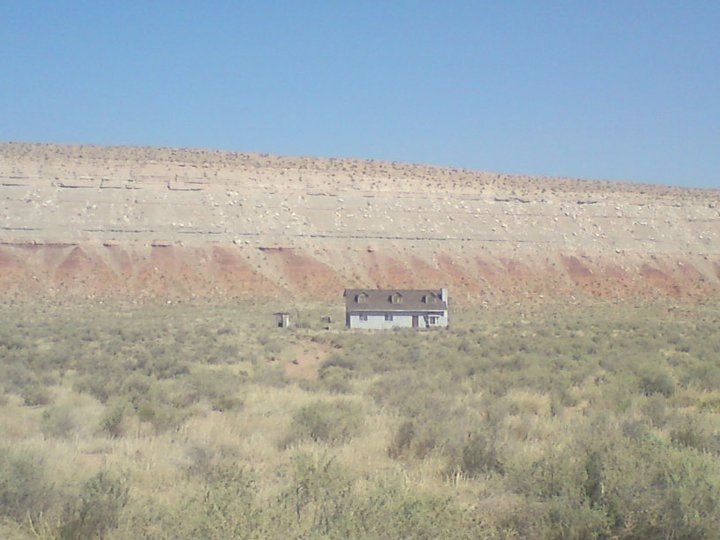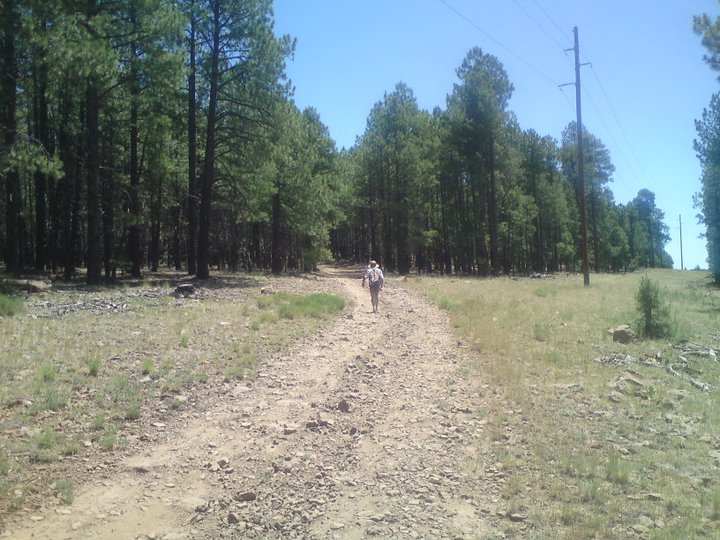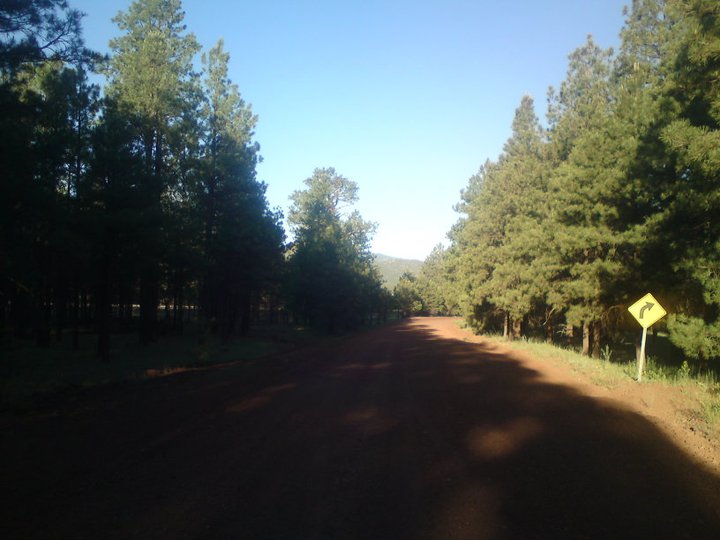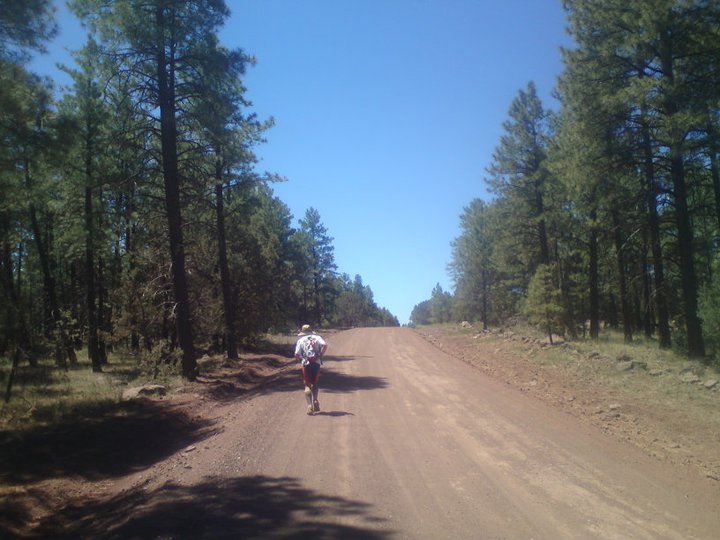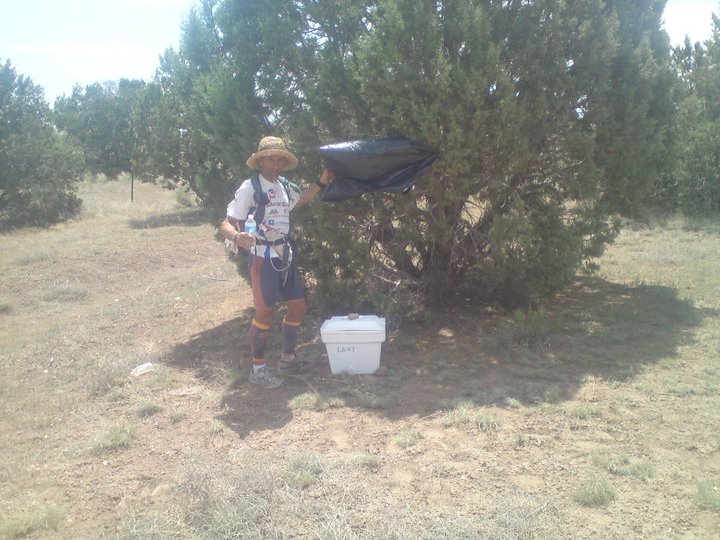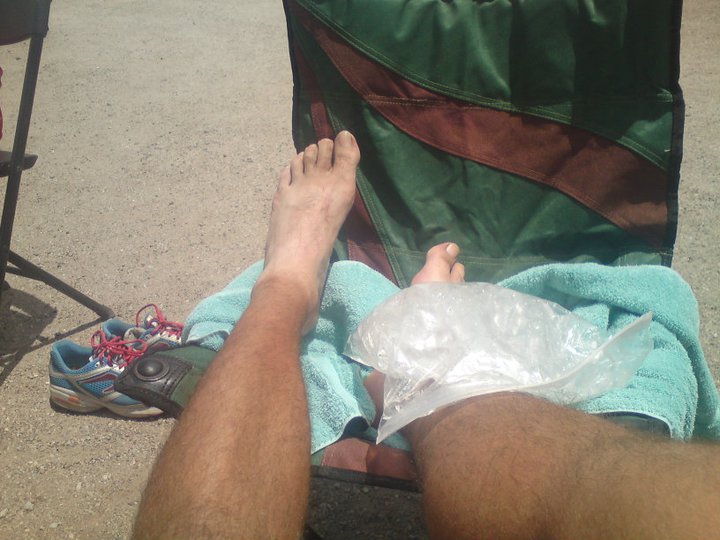LA-NY Footrace Log – Temporary Crew Edition
Day 1
San Diego to Truxton
We (my life partner Scout and I – “life partner” sounds so much more contemporary than “The woman who has tolerated me since the Carter Administration) drive from the domestic pleasures of our fabulous new home in San Diego to something called Truxton, Arizona. Why? The answer is obvious to any man who’s been married 30 years: because I was told to do so. After this many years of wedded bliss (translation: servitude), the rational man follows orders and keeps his mouth shut.
Why Truxton? A friend there – an acquaintance, really; actually an acquaintance of an acquaintance and a foreigner to boot – is running something call the LANY Footrace Across America, the victims of which start in Los Angeles and, after 70 days of suffering horrible agonies and a lot of bad, bad food, slog into New York City, where they will be mugged and derided as rubes. (Note to all non-New Yorkers: anyone not from New York City is a “rube,” or a “hick,” a person of no sophistication or cultural attainment. Please be aware of this as you traverse NYC’s many areas awash in sewage, human excrement and unburied corpses.)
Scout and I will again provide an extremely modest – trivial, really - amount of assistance for a few days to James Adams, a Brit who looks a little like the American actor David Birney once did back in the day when he was starring in second-rate TV shows and was in a second-rate marriage to American actress Meredith Baxter. To us (i.e. elderly strangers) James is a quiet, low-maintenance guy who probably finds the intrusion of a “crew” a bloody nuisance imposed by the race directors. True, there is the minor matter of needing to consume gallon after gallon of Gatorade during day after day under a blazing sun, but, one feels James would prefer that America had drinking fountains every few miles. Don’t we all.
The David Birney element may explain why the few women involved on the LANY trek are quick to ask us: “How is Zhames? Please, tell us about how is ze Zhames?” While this may simply be that the European women might like to see what it’s like on the other side of “The Channel” as it were, it also says something else about “Zhames.” While he is probably emotionally open and loads of fun among (younger, open and fun) friends, it’s “I’m all right, Jack!” when discussing the abuse his body takes during day after day of long mileage. This is good for us, since we have no skills with which to mitigate the aches and pains. (Our motto is: “You want ice? You want ibuprofen? You don’t want ice or ibuprofen, then shut your festering gob.”)
Ah, Truxton. There may have once been a reason for there to be a Truxton, but now…not so much. All that remains is a few dilapidated buildings around a dilapidated motel consisting of seven rooms. Baking heat, sand, and a few scrubby plants that have chosen the terribly bad option of desert for a habitat. As we pull in, James waits in the parking lot in his Robinson Crusoe look – and what appear to be fuzzy slippers. Obviously the latest thing in post-run wear for the ultra crowd, and I didn’t actually see bunny ears on them. James is very James-y. Only admitted to a little concern that the throbbing pain in his shins could be a problem. But maybe not. It might get better. If it moved to his ankles or knees or feet, that would be a good sign that the issue was a generalized, free-floating agony rather than a specific one. We agree that stress fractures are a bad thing, especially so early in the race. Running on broken bones in Ohio or West Virginia would be preferable to running on them in California and Arizona. Given that I have a history of withdrawing from races due to hangnails, chapped lips, and occasional feelings of “bad karma,” James’ attitude is completely foreign. More to the point, his revelation that his legs are troubling him is something – for him - akin to a screaming, thrashing nervous breakdown; not very James-y at all.
We stare at his legs for awhile, then at the room the three of us will share tonight. Like most dumpy motels in the U.S., Truxton’s has a “window unit” air conditioner, which generates a tremendous amount of noise, but not much cool air. James shrugs. (Later in the night as I lie awake dripping with sweat, I realize that the B-52 engine noise I hear isn’t the A/C: it’s James’ snoring. ) The room is a doozy, cluttered with James’ belongings, with food and water provided by the race organizers and with things that Laurie and another crew have provided – things similar to the ones we have brought. A quick look around leads one to conclude that we should have rented a van. This was an issue at Badwater last year, too, with mountains of stuff from which we were seldom able to extract the necessary items at the necessary time. James would say “Maybe at the next stop,” and run off while we accused each other of letting him down. But we learned from it and yet somehow brought an even smaller vehicle. Hm.
Chief among the pleasures of Truxton was…how can I put this?… the smell. Faced with the challenge of running for 70 days, James has opted for the time-honored guy approach of wearing the same stuff until it stinks too much to endure, then moving on to another set of togs. (He will later state that he packed 30 running tops.) There is loose talk about rinsing things out in the sink, but we doubt that this has often occurred. Given the odor and the lack of results from the A/C, it is well that James leaves his door open -even in the heat of Truxton.
As a modern man, James has a blog to post and will sacrifice sleep to update it once the old folks have toddled off to bed. We do so, but in the back of our minds we wonder: Why has James left a pair of European-looking (i.e., skimpy) underpants on the floor of his room? Why would he change out of his smelly running clothes into “ball-hugger” shorts and then – evidently later in the same evening – discard them? Ah, the British.
Day 2
Truxton to Seligman
We awaken at 4:30 am and begin to argue about how best to pack the car. The race organizers have provided participants with supplies for a breakfast of coffee, bread and jam, the perfect way to start off a 6,000 calorie day. James shrugs when asked how his aching legs are doing. We decide to “let him have his privacy” (i.e., ignore the problem) and hope for the best during today’s 46 mile mad-dog run to Seligman, a virtual metropolis after Truxton. As the runners hobble out of the, uh, town, we learn that the mystery panties did not belong to James and were on the floor when he checked in. Ewww.
Yeah, you do wonder: Who checks into a room which has clothing on the floor from a previous tenant? But this is life in carefree (and hygiene-free) Truxton – and among these ultra-est of ultra runners. None of these folks are likely to be dissuaded by a surprise on the floor unless it makes noise louder than the A/C.
Ignoring left-over panties is, in a way, characteristic of ultra runners. Like James, all of the participants in the LANY have extensive resumes from other races and other challenges. These are people who say things like “I anticipate that the pain will ease up after Ohio.” The only remaining woman here dropped out of a trans-Asia race due to pelvic fractures. Yeah, those can be a bummer. Six of the original 14 race entrants have dropped out but most are still here and running every day, having recovered from whatever incapacitated them – or having decided to keep on going despite injuries. This is a far, far different mindset than those of us who bitch and moan because it was too hot during our Fourth of July 15K in San Diego.
The daily program is as follows: after the runners hobble out of town, we drive two miles, then open the trunk and offer James water or Gatorade and/or various high energy snacks when he reaches us. Usually he just wants Gatorade. He eats a few of the turkey sandwiches we made in advance, but it’s hard to tell if this is nutrition or just good manners. Later, he’ll want a “Monster” or two, one of those high caffeine, high sugar drinks that probably cause brain cancer. Chug-a-lug, buddy!
The route from Truxton to Seligman is along “Historic Route 66,” a section of U.S. highway only “historic” because there was once a TV show named “Route 66” - even it was a fantasy about how these two cool guys bumped into towns along the road and had adventures, met girls, etc. There was a song, too, about a road from Chicago to LA, but the interstate system came along and bypassed most of the little towns along Route 66 so that it long ago became a relic. Towns along the old road (the “Mother Road” according to some) hype their attachment to manufactured nostalgia. It’s a teensy-weensy copy of what one sees in Egypt with the pyramids and in Mongolia with Genghis Khan: Hey! Look at us! We were cool once! Before we were born, but what the hell!
Still, Route 66 passes through an America that someone visiting Broadway or Disneyland would never know exists. For better or worse, folks here (and in Texas, Iowa, etc) are a face of America, too. Not surprisingly, they often feel neglected by the ever-more-urban U.S. of A and many of them are angry.
Many of them are also fat, yet another U.S. characteristic, and one that probably has, in some way, something to do with that sense of being passed by, of being unimportant. Uh-oh, Dave has drifted into one of his “lost America” reveries. Quick! Get him a Monster…or a swift kick.
We pass out Gatorade and, as the day drags on, hope that James is feeling better (translation: We hope he’ll hurry up so we can finish!). Remarkably, James, now a Londoner, does better in the desert heat than some of the others though no one is exactly sprinting. It’s hot and even the many charms of Seligman are only a modest incentive. James wants to lie on the asphalt in the motel parking lot with his bad (worse?) ankle up on a chair with ice on it while he sips a beer. This is the happiest he’s been all day. Gee. Wonder why.
Dinner is a Subway sandwich, chips and a soft drink. Somewhere in the back of my nutrition-ignorant mind is the thought that he ought to be eating a high-fiber, high-vitamin, high-everything concoction to help him face the next day. Probably true, but he wants a Subway Italian BMT. What the hell.
Wind has been an issue and James has struggled to wear the floppy sun hat he brought, eventually going bare-headed. Since Scout’s family crest has “Ach! You’ll get skin canceh!” on it, I think of this often as I struggle to keep my own sun hat in place. The wind – often in the runner’s faces – is a damned nuisance.
On the plus side, James has arranged for us to have our own room in Seligman, perhaps because of our snoring and night-farting. Better still, the A/C works and the floor is free of residue from previous occupants. Also, we can have sex without having to say to James “Turn your back for a minute, will you? This won’t take long.”
In Seligman, we also meet a few of the other participants/crew/organization people. One of the runners is French; his wife is honcho of the six-person organization team. A few of them speak passable English; no one seems to know much French. The organizers had limited entrants to 30, but only 14 signed up. At $6,500 (U.S.) entry fee, the organizers were looking at about $200,000 front money. With a far smaller field, one has to wonder if any corners have had to be cut. Who knows? Runners get a supply of water (70 ½ liter bottles), Coca Cola (24 12 oz. cans), a few gels, a few energy bars, and a loaf of bread every five days. Organizers clearly state that this is not enough to sustain the runners. No kidding. Even so, wrestling with waters, the Coca Cola, and ice has been a chore for us.
Two of the participants are Dutch: One, the woman who had pelvic fractures in Asia, is accompanied now by her sister and brother-in-law and by Annike, a friend who carries water/Gatorade, etc. on a bike. The runner (Jenni/ “Yenni”) has had to drop out from the “official” competition due to injury, but runs with the participants daily and looks strong and steady. Her sister teaches ice-skating in Friesland, in the northern part of Holland. Her brother-in-law Theo gives us a bit of ribbon with the Friesland flag on it. As with everyone else we’ve met, these people are sweet and generous and, like us, a little amazed to be participating – even on a crew – in such a demanding undertaking. Like us, the Dutch say that they “only” do marathons; like us, they recognize that what we both think of as a big and demanding achievement isn’t even a day’s journey here. We all feel like pussies.
Like us, Theo and his wife will drop out after a few days and go home. Jenni and Annike will continue.
The race front runner is Rainier Koch, a German, who seems to have the best – and most disarming – organization. Rainier, 30, is a runner; his racing partner Peter, 69, operates a “kick bike,” which is a glorified skateboard with bike wheels. Peter pushes off with one foot for a moment or two, then switches to the other. He used to be a runner, but gave it up. Too tough, he says. Now he’s “kicking” his way across America.
Rainier and Peter room together with June, a young Korean woman who met Rainier two years ago at a trans-European race. June was there with a Korean entrant who got hurt and dropped out. She decided to stay on; two years later when Rainier contacted her about crewing for the two men, she said yes. She says she hopes her next adventure will be a race across Australia, either with Rainier or with someone else she meets on this race. I hesitate to say “groupie,” but June seems like she wants to leverage these events into trips to foreign countries. She’s certainly seeing the U.S. in a way the average visitor never would. To be fair, her work day starts before 5:30 (when the day’s “race” begins) and probably includes tending to the two men for hours after their day ends. Despite the long hours, she is genuinely sweet and kind and funny. We have no idea if there is any “relationship” linkage between her and either of the men and no idea about how costs are allocated, but this has to be a huge commitment on her part, as well as on theirs; June is in it for the long haul.
One last Rainier story: As the race nears The Grand Canyon, Rainier has planned to hike the canyon during his “free time,” that is to say, after he has run the 30 or so miles from Ashfork to Williams. Gotta say, if you’ve never seen the Grand Canyon, go see it. If you’re running 40 or so miles a day for 70 consecutive days…buy a postcard.
We reach Seligman and, blissfully, sleep in our own room. Having crewed for James at Badwater, we don’t question him a lot about what hurts some and what hurts a lot. If he wants to tell us, he will and, considering how little we can help, what’s the point of dwelling on it? While this may seem cavalier, we sense that James has no interest in spilling his guts to relative strangers. His blog is more candid about highs and lows; still, what can we do? Say “Atta Boy”?
Day 3
Seligman to Ashfork. This is “only” a 30 mile day and James has hoped it is a chance for him to rest his aches and pains. We hit town…and immediately drive on to Williams, a larger town with a better motel. We’re supposed to sleep in James’ room here, too, but opt for – and pay for – our own. Typically, a runner pays for crew lodging and food as well as his own. James anticipates that the total cost of this challenge will run near $12,000 U.S. We hope not, but, 70 nights of lodging, plus dinners, plus supplies, etc., etc., and the tally adds up quickly. This is no game for cheapskates. The participants may be low maintenance, but the costs are substantial. Subway sandwiches for three (including drinks and chips) = $30 U.S.
Annike, the Dutch biker, walks by, telling me she wants to see the sights of Ashcroft. I’m pretty sure she’s kidding. Once we hit Williams, we find a ribs place. James opts for chicken, a safer choice, but then, he has to run tomorrow. This is America, too: restaurant food in small towns, each with its own idea of what “ribs” or anything else tastes like. MacDonald’s and Starbucks may pride themselves on the consistency of their product, but ribs taste different in El Paso than in Williams. There really is such a thing a “local flavor.”
Day 4
Ashfork to Williams. We drive James back to Ashfork, get ice, and are on the road again. We dole out the drinks and the occasional snack and hope we’re doing the right thing for our guy. He agrees that we should urge him to eat more during the day (hint: try the four day old turkey sandwiches), but he generally does not want to eat during the day and nagging seems like dirty pool considering what he’s going through. There are times when he seems a bit lower than others, but saying stupid things like “Buck up, you’re doing great!” seems so empty when the road ahead is so long. Perhaps there should be a manual for this.
James has volunteered us to assist Italo, an Italian runner who has no crew. Italo is, like James, low maintenance. If anything, Italo is lower maintenance; he drinks little and eats less. We try to get him to eat one of the pre-ptomaine turkey sandwiches; he eats half. “I am a little man,” he says. True, but strong and, if one had to guess, one would think he’ll still be in the race at the end.
We reach Williams and get James a Big Mac, fries, and a strawberry shake, a meal composed almost entirely of poisons and carcinogens. Later, we all go with Italo to a “pizza” place, the quotation marks in honor of Italo’s heritage. Like anyone from another country who sees the American version of a product from their native land, he smiles a little to see what the U.S. has done to the food he knew. Still, we all dig in and the boys even take the leftovers back to their room for breakfast tomorrow. James is moving better – if not exactly comfortably – after the usual ankle icing at the end of the day. This seems like one dynamic for these runners: they know they aren’t going to feel or move well until this is over so they just accept the way things are. The departure each morning is almost painful to watch, each participant slowly finding a way to run/walk into the morning sun.
The road has been gradually uphill since the second day, “gradually” being a more operative word for those of us driving with an elevation map in our lap. For the runners, it’s a never-ending series of long climbs. We try saying things like “Most of the climb is in the first 20 miles,” but there are hills in every part of each day and, like almost anything else we think of to say, out topographical observations are gibberish. On the plus side, the low, scraggly shrubs have given way to mesquite and eventually to pines. At least decent cover to empty one’s self behind.
Life is simple for the crew: if there’s enough ice, we’re okay. We get a bit ahead of the guys, stop and read a few pages of our books and wait to see them in the rearview mirrors. I’m reading a book about a photographer in the 1930s; Scout is reading about a Chinese study that supported the hypothesis that meat-based diet is bad. Did I mention we had pizza last night? Sausage made from snouts, intestine,s and anuses?
We try to provide updates on the route, but most of it is straight forward and the conversation is a little silly. “Tough hill. You guys are rockin.” No one wants to discuss the Greek debt crisis or why the U.S. is fighting for the Afghans, who despise us, but not for the Libyans, who are begging for help. It’s a disservice to ask a runner to enter into a real conversation; they may welcome a distraction – and a rest – but they need to get back on the road.
We haven’t run ourselves since Sunday and so try to go for an hour after James and Italo have settled down in Williams. Unhappily, at 7,000 ft elevation, we are even more pathetic than we had feared and hobble down a little piece of the same road that the guys hobbled…only we hadn’t been running huge distances for 12 straight days. James is gracious – as always – when we tell him about this. Even as we try to make it into a funny anecdote, the contrast between our little jog and the weight of what the guys are doing is hard to ignore. I’m guessing the guys aren’t really interested in hearing about how difficult the task before them is. “Shut your festering gob!”
Day 5
Williams to Flagstaff. After a 46 miler and two 30s, this is a 40. James is still icing, but says his legs are better. The shin splints are better and the ankle, if still swelling, seems less of an issue – or at least seems to be something he’s able to live with. We hope so.
After days of tough climbs and hot temperatures, this day has a little less of each. As this is our last day, James has approached the race organizers about support for the rest of the race. Tough love from the French. He has to discard some of his clothing, food, and peripherals to get down to the minimum he can carry. Again, I wonder if the shortage of entrants has resulted in a shortage of flexibility in this area. The race rules only require two weeks of crew support. What did the organizers think was going to happen then? We take a few of his things so he doesn’t have to throw them away; still, it feels disloyal to be “abandoning” him, especially with his injury (Or two? Five?). Still, this is what we signed up for and we’re looking forward to getting home.
We watch the other runners. They are unfailingly friendly and, even as their energy flags, have a little wave or a word for anyone who offers encouragement. Most speak some English. The Germans, Dutch, French, and Italians seem a bit more comfortable in English than the Japanese. Based on watching the support crews drive rented cars in Williams, I’d say the Italians and Japanese struggled with American signs and roads the most. Stop signs seem to especially baffle to Italians.
We part ways in Flagstaff, James with a Jumbo Jack, fries, and a strawberry shake in hand; us with a nine hour drive back home. He told us at one point that he hadn’t wanted his girlfriend to come along on this trek. It makes sense: someone with too close of a personal tie also has too much emotional weight. A racer owes that person more personal attention and warmth than the racer can pay out during so demanding an endeavor. In that way, perhaps Laurie and Scout and I were more useful than a loved one would be because of our emotional neutrality. On the other hand, someone close could offer a deeper kind of emotional support at times when a runner’s spirits get low. Who knows? We did the best we could with what we had.
I was interviewed on camera one day and asked about the race and the racers. At the time, I thought I had a pretty good handle on how remarkable their mental toughness was, their resilience, their drive to push through despite the fatigue and the injuries. In retrospect, I think my perception only touched a small part of the surface. Deeper than the obvious issues like fatigue and injuries is the emotional toll. Those of us watching from the sidelines, even the ones handing out bottles of drink, cannot grasp how much determination it takes to face that. We can only marvel. Rock on James.



